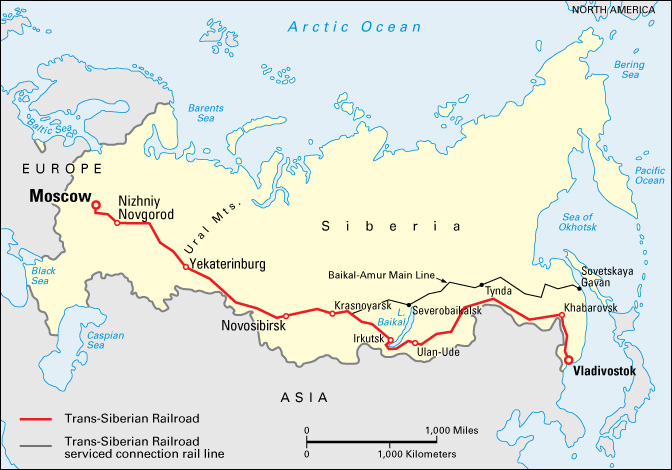Transcontinental railroad is a system of rail lines that reaches across a continent. The term is commonly used to refer to the series of rail lines that linked the eastern and western coasts of the United States in the 1860’s. Tracks laid by two rail companies met in Utah in 1869, making North America the first continent to have a rail line from coast to coast. The Canadian Pacific Railway completed Canada’s first transcontinental line in 1885. Extensive rail networks were also built in other parts of the world in the late 1800’s and early 1900’s. The railroads opened up vast regions to settlement, farming, and trade.
The United States.
Beginning about 1830, the first steam locomotives began serving passengers in the United States. By 1850, rail lines served every U.S. state east of the Mississippi River. In 1857, the Baltimore and Ohio Railroad reached from Baltimore, on the East Coast, to St. Louis, just west of the Mississippi.
In the early 1860’s, the U.S. government decided to extend rail lines across the country. The proposed route roughly followed the 42nd parallel from Omaha, Nebraska, to Sacramento, California. Eastern rail lines were to extend westward from Chicago to meet the new railroad at Omaha. The Pacific Railroad Act, passed by Congress in 1862, gave two companies responsibility for building the railroad between Omaha and Sacramento. The Union Pacific was to start laying track westward from Omaha, and the Central Pacific Railroad was to lay track eastward from Sacramento. Congress granted both railroads large tracts of land and millions of dollars in government loans.
Work began on the Central Pacific track in 1863 and, after a slow start, on the Union Pacific track in 1865. The railroads faced the task of crossing the Rocky Mountains and the Sierra Nevada. The Central Pacific hired thousands of Chinese immigrants to work on the railroad. Thousands of European immigrants, hundreds of African Americans, and many former American Civil War soldiers worked on the Union Pacific. On May 10, 1869, the tracks of the two railroads met at Promontory, Utah.
Around the world.
The first public railroad opened in England in 1825. By 1870, most of Europe’s major rail systems had been built. The Orient Express, one of the most famous European passenger trains, began crossing most of Europe—between Paris, France, and Istanbul, Turkey—in 1883.
In South America, Argentina and Brazil built extensive rail networks in the late 1800’s. Also in the late 1800’s, France, Germany, and the United Kingdom built railroads in their African and Asian colonies. Russia built its 5,600-mile (9,000-kilometer) Trans-Siberian railroad between 1891 and 1916. The Trans-Siberian, connecting Moscow in the west to Vladivostok on the Pacific Ocean, is the world’s longest continuous railroad line. Australia built a railroad across its southern plains from 1912 to 1917. The line extends 1,100 miles (1,770 kilometers) from Port Pirie to Kalgoorlie. In 2003, workers completed Australia’s first north-south transcontinental railroad. It stretches from Adelaide in South Australia to Darwin in the Northern Territory, a distance of 1,851 miles (2,979 kilometers).

